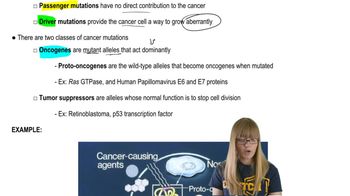Table of contents
- 1. Introduction to Genetics51m
- 2. Mendel's Laws of Inheritance3h 37m
- 3. Extensions to Mendelian Inheritance2h 41m
- 4. Genetic Mapping and Linkage2h 28m
- 5. Genetics of Bacteria and Viruses1h 21m
- 6. Chromosomal Variation1h 48m
- 7. DNA and Chromosome Structure56m
- 8. DNA Replication1h 10m
- 9. Mitosis and Meiosis1h 34m
- 10. Transcription1h 0m
- 11. Translation58m
- 12. Gene Regulation in Prokaryotes1h 19m
- 13. Gene Regulation in Eukaryotes44m
- 14. Genetic Control of Development44m
- 15. Genomes and Genomics1h 50m
- 16. Transposable Elements47m
- 17. Mutation, Repair, and Recombination1h 6m
- 18. Molecular Genetic Tools19m
- 19. Cancer Genetics29m
- 20. Quantitative Genetics1h 26m
- 21. Population Genetics50m
- 22. Evolutionary Genetics29m
19. Cancer Genetics
Overview of Cancer
Problem 17
Textbook Question
DNA sequencing has provided data to indicate that cancer cells may contain tens of thousands of somatic mutations, only some of which confer a growth advantage to a cancer cell. How do scientists describe and categorize these recently discovered populations of mutations in cancer cells?
 Verified step by step guidance
Verified step by step guidance1
<span>Understand the types of mutations: In cancer cells, mutations can be categorized into 'driver' mutations, which contribute to cancer progression, and 'passenger' mutations, which do not confer a growth advantage.</span>
<span>Identify driver mutations: Scientists use various methods, such as statistical analyses and functional assays, to identify which mutations are likely to be driver mutations.</span>
<span>Characterize passenger mutations: These are mutations that accumulate in cancer cells but do not directly contribute to cancer growth. They are often used as markers to study the history and evolution of cancer cells.</span>
<span>Use sequencing data: High-throughput DNA sequencing technologies allow scientists to sequence the entire genome of cancer cells, providing a comprehensive view of all mutations present.</span>
<span>Apply bioinformatics tools: Scientists use computational tools to analyze sequencing data, distinguishing between driver and passenger mutations based on their frequency, location, and impact on protein function.</span>
Recommended similar problem, with video answer:
 Verified Solution
Verified SolutionThis video solution was recommended by our tutors as helpful for the problem above
Video duration:
47sPlay a video:
Was this helpful?
Key Concepts
Here are the essential concepts you must grasp in order to answer the question correctly.
Somatic Mutations
Somatic mutations are genetic alterations that occur in non-germline cells, meaning they are not inherited but arise during an individual's lifetime. These mutations can result from environmental factors, errors in DNA replication, or other cellular processes. In cancer, somatic mutations can accumulate and contribute to tumorigenesis by altering cell behavior, such as promoting uncontrolled growth.
Recommended video:
Guided course

Point Mutations
Tumor Heterogeneity
Tumor heterogeneity refers to the presence of diverse cell populations within a single tumor, which can differ genetically and phenotypically. This diversity arises from the accumulation of somatic mutations and can lead to variations in how cancer cells respond to treatment. Understanding tumor heterogeneity is crucial for developing effective therapies, as some mutations may confer resistance to specific drugs.
Recommended video:
Guided course

Cancer Characteristics
Oncogenic Mutations
Oncogenic mutations are specific genetic changes that promote cancer development by enhancing cell proliferation or survival. These mutations often affect genes involved in critical pathways, such as those regulating cell cycle, apoptosis, and signal transduction. Scientists categorize mutations based on their functional impact, distinguishing between driver mutations, which contribute to cancer progression, and passenger mutations, which do not affect tumor growth.
Recommended video:
Guided course

Cancer Mutations

 9:51m
9:51mWatch next
Master Cancer Characteristics with a bite sized video explanation from Kylia Goodner
Start learningRelated Videos
Related Practice


